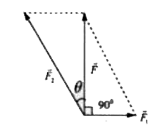Sum of magnitude of two forces is 25 N. The resultant of these forces is normal to the smaller force and has a magnitude of 10 N. Then the two forces areSolution in Telugu
14.5 N, 10.5 N
16 N, 9 N
13 N, 12 N
20N, 5N
The correct Answer is:A
F1+F2=25
⇒F1+F2cosθ=0
Fres=√F21+F22+2F1F2cosθ
⇒100=F21+F22+2F1F2cosθ
⇒F21+(25−F1)2+2F1F2cosθ=100
F21+625+F21−50F1+2F1F2cosθ=−525
50F1=525
F1=10.5,F2=25−10.5=14.5.
Similar Questions
The sum of magnitudes of two forces acting at a point is 16N. If their resultant is normal to the smaller force and has a magnitude of 8N. Then the forces are

View SolutionTwo forces are such that the sum of their magnitudes is 18N and their resultant is 12 N which is perpendicular to the smaller force. Then the magnitude of the forces are
View SolutionSum of magitude of two fores is 25 N. The resultant of these forces is normal to the smaller force and has a magnitude of 10 N. Then the two forces are
View SolutionSum of magnitudes of the two forces acting at a point is 16 N if their resultant is normal to the smaller forces and has a magnitude 8N then the forces are .
View SolutionThe sum of magnitudes of two forces acting at a point is 16N. If their resultant is normal to the smaller force and has a magnitude of 8N. Then the forces are

View SolutionTwo forces are such that the sum of their magnitudes is 18N and their resultant is 12 N which is perpendicular to the smaller force. Then the magnitude of the forces are
View SolutionThe sum of the magnitudes of two forces acting at a point is 18 N and the magnitude of their resultant is 12 N. If the resultant is at 90∘ with the smaller force, the magnitude of the forces in N are
View SolutionThe sum of magnitudes of two forces acting at a point is 16 N and their resultant 8N is at 90∘ with the force of smaller magnitude. The two forces (in N) are
View Solution

